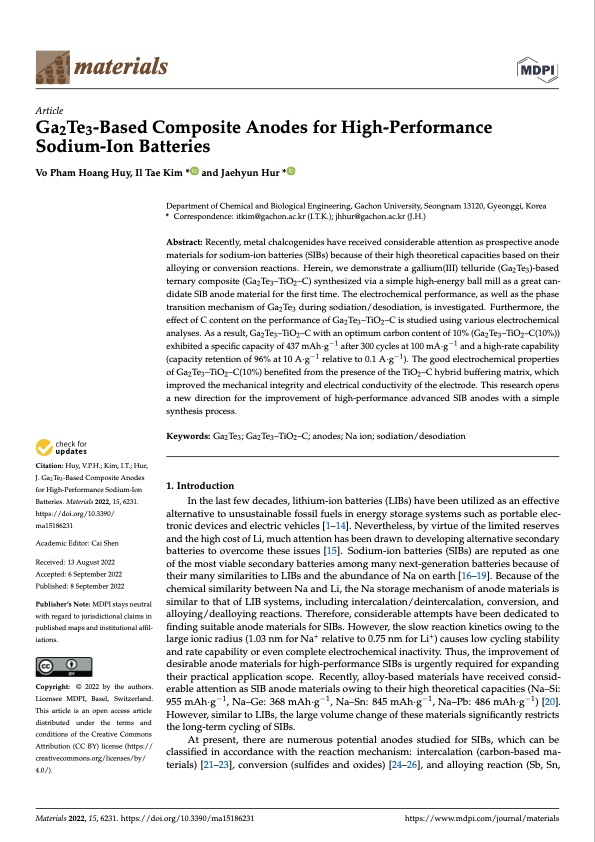
PDF Publication Title:
Text from PDF Page: 001
materials Article Ga2Te3-Based Composite Anodes for High-Performance Sodium-Ion Batteries Vo Pham Hoang Huy, Il Tae Kim * and Jaehyun Hur * Citation: Huy, V.P.H.; Kim, I.T.; Hur, J. Ga2Te3-Based Composite Anodes for High-Performance Sodium-Ion Batteries. Materials 2022, 15, 6231. https://doi.org/10.3390/ ma15186231 Academic Editor: Cai Shen Received: 13 August 2022 Accepted: 6 September 2022 Published: 8 September 2022 Publisher’s Note: MDPI stays neutral with regard to jurisdictional claims in published maps and institutional affil- iations. Copyright: © 2022 by the authors. Licensee MDPI, Basel, Switzerland. This article is an open access article distributed under the terms and conditions of the Creative Commons Attribution (CC BY) license (https:// creativecommons.org/licenses/by/ 4.0/). Department of Chemical and Biological Engineering, Gachon University, Seongnam 13120, Gyeonggi, Korea * Correspondence:itkim@gachon.ac.kr(I.T.K.);jhhur@gachon.ac.kr(J.H.) Abstract: Recently, metal chalcogenides have received considerable attention as prospective anode materials for sodium-ion batteries (SIBs) because of their high theoretical capacities based on their alloying or conversion reactions. Herein, we demonstrate a gallium(III) telluride (Ga2Te3)-based ternary composite (Ga2Te3–TiO2–C) synthesized via a simple high-energy ball mill as a great can- didate SIB anode material for the first time. The electrochemical performance, as well as the phase transition mechanism of Ga2Te3 during sodiation/desodiation, is investigated. Furthermore, the effect of C content on the performance of Ga2Te3–TiO2–C is studied using various electrochemical analyses. As a result, Ga2Te3–TiO2–C with an optimum carbon content of 10% (Ga2Te3–TiO2–C(10%)) exhibited a specific capacity of 437 mAh·g−1 after 300 cycles at 100 mA·g−1 and a high-rate capability (capacity retention of 96% at 10 A·g−1 relative to 0.1 A·g−1). The good electrochemical properties of Ga2Te3–TiO2–C(10%) benefited from the presence of the TiO2–C hybrid buffering matrix, which improved the mechanical integrity and electrical conductivity of the electrode. This research opens a new direction for the improvement of high-performance advanced SIB anodes with a simple synthesis process. Keywords: Ga2Te3; Ga2Te3–TiO2–C; anodes; Na ion; sodiation/desodiation 1. Introduction In the last few decades, lithium-ion batteries (LIBs) have been utilized as an effective alternative to unsustainable fossil fuels in energy storage systems such as portable elec- tronic devices and electric vehicles [1–14]. Nevertheless, by virtue of the limited reserves and the high cost of Li, much attention has been drawn to developing alternative secondary batteries to overcome these issues [15]. Sodium-ion batteries (SIBs) are reputed as one of the most viable secondary batteries among many next-generation batteries because of their many similarities to LIBs and the abundance of Na on earth [16–19]. Because of the chemical similarity between Na and Li, the Na storage mechanism of anode materials is similar to that of LIB systems, including intercalation/deintercalation, conversion, and alloying/dealloying reactions. Therefore, considerable attempts have been dedicated to finding suitable anode materials for SIBs. However, the slow reaction kinetics owing to the large ionic radius (1.03 nm for Na+ relative to 0.75 nm for Li+) causes low cycling stability and rate capability or even complete electrochemical inactivity. Thus, the improvement of desirable anode materials for high-performance SIBs is urgently required for expanding their practical application scope. Recently, alloy-based materials have received consid- erable attention as SIB anode materials owing to their high theoretical capacities (Na–Si: 955 mAh·g−1, Na–Ge: 368 mAh·g−1, Na–Sn: 845 mAh·g−1, Na–Pb: 486 mAh·g−1) [20]. However, similar to LIBs, the large volume change of these materials significantly restricts the long-term cycling of SIBs. At present, there are numerous potential anodes studied for SIBs, which can be classified in accordance with the reaction mechanism: intercalation (carbon-based ma- terials) [21–23], conversion (sulfides and oxides) [24–26], and alloying reaction (Sb, Sn, Materials 2022, 15, 6231. https://doi.org/10.3390/ma15186231 https://www.mdpi.com/journal/materialsPDF Image | Ga2Te3-Based Anodes for Sodium-Ion Batteries

PDF Search Title:
Ga2Te3-Based Anodes for Sodium-Ion BatteriesOriginal File Name Searched:
materials-15-06231.pdfDIY PDF Search: Google It | Yahoo | Bing
Salgenx Redox Flow Battery Technology: Salt water flow battery technology with low cost and great energy density that can be used for power storage and thermal storage. Let us de-risk your production using our license. Our aqueous flow battery is less cost than Tesla Megapack and available faster. Redox flow battery. No membrane needed like with Vanadium, or Bromine. Salgenx flow battery
| CONTACT TEL: 608-238-6001 Email: greg@salgenx.com | RSS | AMP |